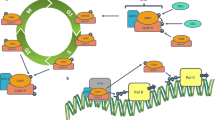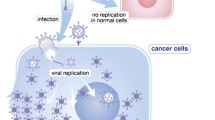Abstract
Reconstitution of the p53-dependent apoptotic pathway by gene transfer of a recombinant wild-type p53 minigene leads to rapid apoptotic cell death in breast and other cancer cell types expressing null or mutant p53. Tumour cells expressing wild-type p53 have been reported to be more resistant to this treatment strategy, presumably as a result of mutations in downstream regulators of p53-dependent apoptotic signalling. The MCF-7 breast cancer cell line is representative of this class of tumour cell. Our recent observation of a p53-dependent apoptotic response following adenovirus-mediated HSV thymidine kinase gene transfer and gancyclovir treatment led us to reexamine recombinant p53 cytotoxicity in MCF-7 cells. Infection with a recombinant adenovirus expressing wild-type p53 resulted in a dramatic increase in p53 protein levels and was accompanied by an increase in p21WAF 1/CIP1 protein levels and G1 arrest within 24 hours post-infection. A significant decrease in MCF-7 cell viability was first observed at 5 days post-infection and coincided with the appearance of morphological and biochemical changes consistent with apoptotic cell death. By day 7 post-treatment, cell viability decreased to 45% and clonogenic survival was reduced to 12% of controls. The results demonstrate that persistent, high level expression of recombinant p53 can induce programmed cell death in MCF-7 cells. While the mechanism by which p53 overexpression overcomes the defect in downstream apoptotic signalling is not clear, our data suggests that this treatment strategy may be beneficial for the class of tumour cells represented by the MCF-7 cell line.
Similar content being viewed by others
References
Beaudry GA, Bertelsen AH, Sherman MI: Therapeutic targeting of the p53 tumor suppressor gene. [Review.] Curr Opin Biotechnol 7: 592–600, 1996
Su N, Ojeifo JO, MacPherson A, Zwiebel JA: Breast cancer gene therapy: transgenic immunotherapy. [Review.] Breast Cancer Res Treat 31: 349–356, 1994
Harris AL, Fox S, Bicknell R, Leek R, Relf M, LeJeune S, Kaklamanis L: Gene therapy through signal transduction pathways and angiogenic growth factors as therapeutic targets in breast cancer. [Review.] Cancer 74: 1021–1025, 1994
Martin SJ, Green DR: Apoptosis as a goal of cancer therapy. [Review.] Curr Opin Oncol 6: 616–621, 1994
Martin SJ, Green DR: Apoptosis and cancer: the failure of controls on cell death and cell survival. [Review.] Crit Rev Oncol-Hematol 18: 137–153, 1995
Kovach JS, Hartmann A, Blaszyk H, Cunningham J, Schaid D, Sommer SS: Mutation detection by highly sensitive methods indicates that p53 gene mutations in breast cancer can have important prognostic value. Proc Natl Acad Sci USA 93: 1093–1096, 1996
Norberg T, Jansson T, Sjogren S, Martensson C, Andreasson I, Fjallskog ML, Lindman H, Nordgren H, Lindgren A, Holmberg L, Bergh J: Overview on human breast cancer with focus on prognostic and predictive factors with special attention on the tumor suppressor gene p53. [Review.] Acta Oncol 35(5): 96–102, 1996
Bergh J, Norberg T, Sjogren S, Lindgren A, Holmberg L: Complete sequencing of the p53 gene provides prognostic information in breast cancer patients, particularly in relation to adjuvant systemic therapy and radiotherapy. Nat Med 1: 1029–1034, 1995
Elledge RM, Allred DC: The p53 tumor suppressor gene in breast cancer. [Review.] Breast Cancer Res Treat 32: 39–47, 1994
Vogelstein B: Cancer. A deadly inheritance [news; comment]. Nature 348: 681–682, 1990
Harris CC: Structure and function of the p53 tumor suppressor gene: clues for rational cancer therapeutic strategies. [Review.] J Natl Cancer Inst 88: 1442–1455, 1996
Kinzler KW, Vogelstein B: Cancer therapy meets p53 [see comments]. N Engl J Med 331: 49–50, 1994
Wyllie AH, Carder PJ, Clarke AR, Cripps KJ, Gledhill S, Greaves MF, Griffiths S, Harrison DJ, Hooper ML, Morris RG et al.: Apoptosis in carcinogenesis: the role of p53. Cold Spring Harbor Symp Quant Biol 59: 403–409, 1994
Casey G, Lo-Hsueh M, Lopez ME, Vogelstein B, Stanbridge EJ: Growth suppression of human breast cancer cells by the introduction of a wild-type p53 gene. Oncogene 6: 1791–1797, 1991
Wills KN, Maneval DC, Menzel P, Harris MP, Sutjipto S, Vaillancourt MT, Huang WM, Johnson DE, Anderson SC, Wen SF et al.: Development and characterization of recombinant adenoviruses encoding human p53 for gene therapy of cancer. Hum Gene Ther 5: 1079–1088, 1994
Katayose D, Gudas J, Nguyen H, Srivastava S, Cowan K, Seth P: Cytotoxic effects of adenovirus-mediated wild type p53 protein expression in normal and tumor mammary epithelial cells. Clin Cancer Res 1: 889–897, 1995
Li P, Klamut HJ: Differential chemosensitivity of breast cancer cells to gancyclovir treatment following adenovirus-mediated HSVtk-gene transfer. (submitted), 1998.
Celis A, Celis JE: General procedures for tissue culture. In: Celis JE (ed) Cell Biology: A Laboratory Handbook. Academic Press, San Diego, 1994
Graham FL, Prevec L: Methods for construction of adenovirus vectors. Mol Biotechnol 3: 207–220, 1995
Zhang WW, Koch PE, Roth JA: Detection of wild-type contamination in a recombinant adenoviral preparation by PCR. Biotechniques 18: 444–447, 1995
Zhang WW, Alemany R, Wang J, Koch PE, Ordonez NG, Roth JA: Safety evaluation of Ad5CMV-p53 in vitro and in vivo. Hum Gene Ther 6: 155–164, 1995
Brezden CB, Rauth AM: Differential cell death in immortalized and non-immortalized cells at confluency. Oncogene 12: 201–206, 1996
Hale AJ, Smith CA, Sutherland LC, Stoneman VE, Longthorne VL, Culhane AC, Williams GT: Apoptosis: molecular regulation of cell death [published erratum appears in Eur J Biochem 1996 May 1; 237 (3): 884]. [Review.] Eur J Biochem 236: 1–26, 1996
Spencer SJ, Cataldo NA, Jaffe RB: Apoptosis in the human female reproductive tract. [Review.] Obst Gynecol Surv 51: 314–323, 1996
Tenniswood MP, Guenette RS, Lakins J, Mooibroek M, Wong P, Welsh JE: Active cell death in hormone-dependent tissues. [Review.] Cancer Metas Rev 11: 197–220, 1992
Yonish-Rouach E: The p53 tumour suppressor gene: a mediator of a G1 growth arrest and of apoptosis. [Review.] Experientia 52: 1001–1007, 1996
Meyn RE, Stephens LC, Mason KA, Medina D: Radiation-induced apoptosis in normal and pre-neoplastic mammary glands in vivo: significance of gland differentiation and p53 status. Internatl J Cancer 65: 466–472, 1996
Lowe SW, Ruley HE, Jacks T, Housman DE: p53-dependent apoptosis modulates the cytotoxicity of anticancer agents. Cell 74: 957–967, 1993
Lowe SW, Schmitt EM, Smith SW, Osborne BA, Jacks T: p53 is required for radiation-induced apoptosis in mouse thymocytes [see comments]. Nature 362: 847–849, 1993
Clarke AR, Purdie CA, Harrison DJ, Morris RG, Bird CC, Hooper ML, Wyllie AH: Thymocyte apoptosis induced by p53-dependent and independent pathways [see comments]. Nature 362: 849–852, 1993
Merlo GR, Basolo F, Fiore L, Duboc L, Hynes NE: p53-dependent and p53-independent activation of apoptosis in mammary epithelial cells reveals a survival function of EGF and insulin. J Cell Biol 128: 1185–1196, 1995
Aas T, Borresen AL, Geisler S, Smith-Sorensen B, Johnsen H, Varhaug JE, Akslen LA, Lonning PE: Specific p53 mutations are associated with de novo resistance to doxorubicin in breast cancer patients. Nat Med 2: 811–814, 1996
el-Deiry WS, Tokino T, Velculescu VE, Levy DB, Parsons R, Trent JM, Lin D, Mercer WE, Kinzler KW, Vogelstein B: WAF1, a potential mediator of p53 tumor suppression. Cell 75: 817–825, 1993
Fan S, Smith ML, Rivet DJ, Duba D, Zhan Q, Kohn KW, Fornace AJ Jr, O'Connor PM: Disruption of p53 function sensitizes breast cancer MCF-7 cells to cisplatin and pentoxifylline. Cancer Res 55: 1649–1654, 1995
Miyashita T, Reed JC: Tumor suppressor p53 is a direct transcriptional activator of the human bax gene. Cell 80: 293–299, 1995
Miyashita T, Harigai M, Hanada M, Reed JC: Identification of a p53-dependent negative response element in the bcl-2 gene. Cancer Res 54: 3131–3135, 1994
Silvestrini R, Benini E, Veneroni S, Daidone MG, Tomasic G, Squicciarini P, Salvadori B: p53 and bcl-2 expression correlates with clinical outcome in a series of node-positive breast cancer patients. J Clin Oncol 14: 1604–1610, 1996
Bargou RC, Daniel PT, Mapara MY, Bommert K, Wagener C, Kallinich B, Royer HD, Dorken B: Expression of the bcl-2 gene family in normal and malignant breast tissue: low bax-alpha expression in tumor cells correlates with resistance towards apoptosis. Int J Cancer 60: 854–859, 1995
Joensuu H, Pylkkanen L, Toikkanen S: Bcl-2 protein expression and long-term survival in breast cancer. Am J Pathol 145: 1191–1198, 1994
Krajewski S, Blomqvist C, Franssila K, Krajewska M, Wasenius VM, Niskanen E, Nordling S, Reed JC: Reduced expression of proapoptotic gene BAX is associated with poor response rates to combination chemotherapy and shorter survival in women with metastatic breast adenocarcinoma. Cancer Res 55: 4471–4478, 1995
Teixeira C, Reed JC, Pratt MA: Estrogen promotes chemotherapeutic drug resistance by a mechanism involving Bcl-2 proto-oncogene expression in human breast cancer cells. Cancer Res 55: 3902–3907, 1995
Sumantran VN, Ealovega MW, Nunez G, Clarke MF, Wicha MS: Overexpression of Bcl-XS sensitizes MCF-7 cells to chemotherapy-induced apoptosis. Cancer Res 55: 2507–2510, 1995
Canman CE, Gilmer TM, Coutts SB, Kastan MB: Growth factor modulation of p53-mediated growth arrest versus apoptosis. Gen Dev 9: 600–611, 1995
Knudson CM, Tung KS, Tourtellotte WG, Brown GA, Korsmeyer SJ: Bax-deficient mice with lymphoid hyperplasia and male germ cell death. Science 270: 96–99, 1995
Schott AF, Apel IJ, Nunez G, Clarke MF: Bcl-XL protects cancer cells from p53-mediated apoptosis. Oncogene 11: 1389–1394, 1995
Boise LH, Gonzalez-Garcia M, Postema CE, Ding L, Lindsten T, Turka LA, Mao X, Nunez G, Thompson CB: bcl-x, a bcl-2-related gene that functions as a dominant regulator of apoptotic cell death. Cell 74: 597–608, 1993
Ealovega MW, McGinnis PK, Sumantran VN, Clarke MF, Wicha MS: bcl-xs gene therapy induces apoptosis of human mammary tumors in nude mice. Cancer Res 56: 1965–1969, 1996
Clarke MF, Apel IJ, Benedict MA, Eipers PG, Sumantran V, Gonzalez-Garcia M, Doedens M, Fukunaga N, Davidson B, Dick JE et al.: A recombinant bcl-xs adenovirus selectively induces apoptosis in cancer cells but not in normal bone marrow cells. Proc Natl Acad Sci USA 92: 11024–11028, 1995
Clayman GL, el-Naggar AK, Roth JA, Zhang WW, Goepfert H, Taylor DL, Liu TJ: In vivo molecular therapy with p53 adenovirus for microscopic residual head and neck squamous carcinoma. Cancer Res 55: 1–6, 1995
Drazan KE, Shen XD, Csete ME, Zhang WW, Roth JA, Busuttil RW, Shaked A: In vivo adenoviral-mediated human p53 tumor suppressor gene transfer and expression in rat liver after resection. Surgery 116: 197–203, 1994
Author information
Authors and Affiliations
Rights and permissions
About this article
Cite this article
Li, P., Bui, T., Gray, D. et al. Therapeutic potential of recombinant p53 overexpression in breast cancer cells expressing endogenous wild-type p53. Breast Cancer Res Treat 48, 273–286 (1998). https://doi.org/10.1023/A:1005961705860
Issue Date:
DOI: https://doi.org/10.1023/A:1005961705860




